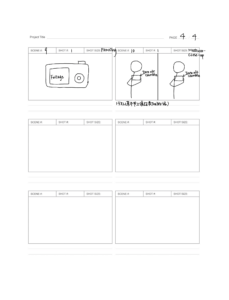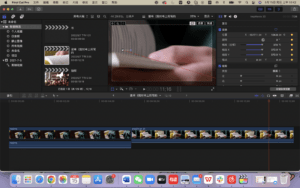Visual Metaphor Documentation

独白 Confession
Video Link: https://b23.tv/PDhCKGk
A. Concept & Story
接受泥沼般的人世间,美丽而真实地活下去
We first thought of Schoolgirl by Osamu Dazai, which contains a collection of female monologues. This piece is about a girl who entirely relies on books and never thinks about things from her own perspective and develops her own ideas.
The added part, the part where her voice is clear and sweet, is from Chongda Cai’s No More Than Skins. This portrays a female character that tries hard to accept her whole self. This is the epiphany of the entire story. We thought that only using Schoolgirl was a bit too depressing. Adding a bit of false hope complicates things and creates more tension inside the entire piece.
The ending line goes back to Schoolgirl. It provides a mystery for the audience. Whether the protagonist gets this epiphany or not is up to the audience’s interpretation. In this case, we thought that this line was the line that described the character’s insaneness to the fullest.
In this video, we want to explore the relationship between reality and fiction, and how some individuals are overly obsessed with books and depend on everything written within it. Also, in this specific character, we want to show her inner struggles.
B. Creation Process & Execution
This is our storyboard ⬇️




After we decided on our narrative content, we started to think about what to shoot to present the metaphor. And after we determined what we would shoot, we then drew the storyboard. As a result, the storyboard mainly works as a guideline for us to monitor what we should shoot. The storyboard mainly provides the angle of the camera, the main content, and the order in which the objects we photographed are arranged, providing our visual metaphor with an outline of the entire project.
We divided our shooting process into several parts. Basically, our shooting is mainly divided into indoor shooting and outdoor shooting. As you can see in our Behind the Scene video, we chose a dorm room as the indoor shooting setting and the playground in our neighborhood as the outdoor shooting setting. Most of the scenes were shot indoors because we want to create a sense of depression. And the reason why we chose the playground as our outdoor setting was that it echoed our concept of fairy tales.
We tried our best to improve our lighting condition. Since we only have two lamps, we mainly focused on medium shots and close-up shots so that the lights shining on the objects would be better. We also chose sunny days with wonderful natural lights so that the lighting could become better. It turns out that the consequence is really nice regarding our lighting.

Most of our sourcing materials came from other people because we didn’t have the materials. So it became a challenge for us to confirm that we could successfully shoot what we proposed. The paper bag, the projector, powder, and card all came from our friends, and they all play crucial roles in our film.

We have also encountered other challenges. For instance, when we went out and shot the scene of the princess the hot temperature and the bright sunshine made it difficult for us to monitor the scenes that we had shot; to achieve the best effect, our voice actor recorded this piece of audio so many times. During the editing process, coloring the scene was also a challenge because we shot the scenes from two cameras and we had to unite the colors of the same scene. Moreover, choosing the most suitable background music is also difficult. We tried jazz, blues, symphony, and piano solos. We were also torn with human sound or without human sound, where to start and where to stop. But after dozens of times of trying, we overcame the difficulties.
We tried and used many techniques when editing our video. In general, we used different softwares: Final Cut Pro, Davinci Resolve, 剪映Pro, and Motion. We created special transitions: one is the transition from the frame to the frame outside the projector and the other one is the transition of the sound of our voiceover (from the telephone to the real sound). In the last part of our movie, we utilized frame drawing, which is Wong Karwai style, to create a sense of old movies & memory. We also used the stop motion effect in the scene of oranges. In our video, we used keyframes not only had the instability been fixed, but also found a wonderful way of moving the camera that we couldn’t achieve in reality through keyframing.



For the princess part, we added a comic filter to create a sense of fairy tales. We also get inspiration from Juxtaposition to split the screen to put the two scenes together. We decided to do this also because we needed to fit the voiceover.

In addition, we tried the video reverse to fit with the metaphor of the narrative voiceover that we have to embrace our true selves, and the video reverse worked very well in our video.

Moreover, we manually created some effects in our video. In the projector part, we artificially created the Tyndall effect by using the powder in front of the projector. In this way, we managed to see the shape of the light and its trajectory, and we managed to create an atmosphere in a movie theater. By utilizing the various mirrors, we managed to create special camera angles to reflect the scenes and objects that we wanted to emphasize.
C. Collaboration
We made this video together from the beginning to the end. We came up with the concept of this video metaphor together. After we settled on the theme, we each started brainstorming what could be photographed, and then we discussed and extracted each other’s good ideas and combined them. Then we shot all the scenes together. Julie played the role of the main actress and Amy was responsible for filming the scenes she acted in. In the other scenes, we shot them together and explored multiple angles with different cameras. After shooting all the scenes, we start to edit the clips together. To improve the efficiency, we first combined several clips together individually, and we combined all these edited clips together on one computer.
Collaborating with my partner helped me discover new inspirations that enriched my imagination during the brainstorming process. Because we both have cameras, we shot together to increase the angle of the same scene, thus giving us more scene options in the subsequent editing process. We can choose scenes that better fit our video and stitch them together. We were also able to explore new techniques from each other, like stop motion from Amy, and keyframe movement, frame drawing from Julie.
Also, working with my partner, I learned the Wong Karwai-style technique of drawing frames and learned to apply this technique to my own projects. Also, I get more familiar with the book Schoolgirl from this experience.

D. Aesthetics & Results
Camera Language: we used close-up shots when introducing the oranges, the pears, and the tablets because we wanted to capture the details of the object. We wanted the audience to focus on the movement and the bubbles.
As for the playground, when introducing how the character used all fantasies in real life, we used medium shots to introduce the colors and give an illusion of the character inside a castle. When we got to the part about failure, we used medium and then shifted to long shots to give the sense of breaking out from fairy tales, entering a playground, a fake castle.
We also used angles like the dutch angle in the mirror scene to show the dramatic self-directing effect; over-the-shoulder shots in the poker scene to show the relationship between the main character and the girl she stole from.
Color correction/adjustment: For the orange scene, we adjusted the color to a brighter and more vivid tone, because we shot the two scenes with 2 different cameras. To unify the shots, we had to adjust the tone. In the playground scenes, we added a filter showing comic effects. This was to add a layer of fantasy to the scene and show the audience that it wasn’t true.
In the scene of frame-drawing, we also adjusted the color and added a filter that gave an old-fashioned look. This was to add an irregular fantasized feeling to the part.
Tone/Pace of video: We wanted the whole video to be sort of lagging and slow. Nothing should be rushed and throughout the video, there will be depressing laziness. This is why we chose blues and symphony for the music.
This is the end of this documentation, and this is also the end of Communications Lab. It is a great pleasure to take this course, to meet Professor Ian, and to meet so many imaginative peers.
At the beginning of the semester, I was confused and terrified about the future of this class, thinking I had no ideas worth showing. But through one semester of study and appreciation, I think I have made great progress compared to myself six months ago. Project by project, I became more courageous to show my work, whether it was good or bad, I learned to use different software to turn my ideas into reality, and I also improved my work step by step with the advice of my instructor.
This semester ended here in the visual metaphor project, and I also think it has drawn a relatively satisfactory end to this course. But at the same time, it is also a starting point, a starting point for me to create future works, and I also believe that in the future I will continue to apply what I have learned in this class.
Finally, thanks to everyone that has helped me during this period of time!
